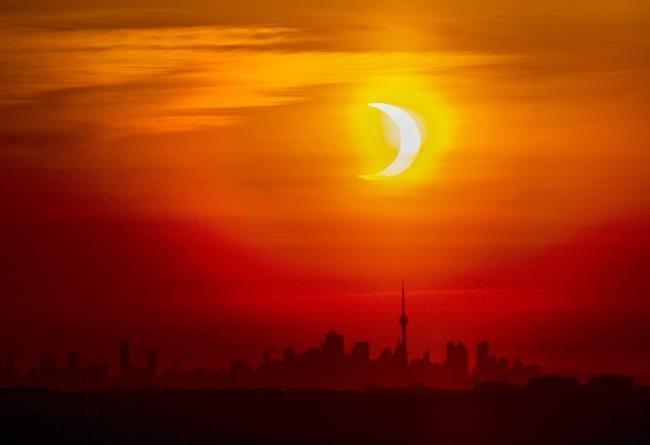FREDERICTON — A total solar eclipse is a rare celestial event that always generates excitement, but next month's version is expected to be unusually spectacular.
The April 8 eclipse that will occur over a large swath of North America, following a path that takes in parts of southern Ontario, Quebec and Atlantic Canada, comes as the sun's magnetic activity is at the peak of an 11-year cycle. That means that during the brief period when the moon totally covers the sun, a show of streamers and magnetic loops will dance around the obscured sun.
Paul Bryans, a scientist at the National Center for Atmospheric Research in Colorado, said that during times of low activity, the sun's corona — the tendrils of light that show the outer limits of the sun's energetic atmosphere — is homogeneous and symmetrical. But this year, he said, the heightened magnetism will make the sun's outer edges spiky like a hedgehog with its quills raised.
"So you have got lots of spikes and activity coming up in different places, and it's hard to really predict exactly where they will be," Bryans said. "But if you're looking at the eclipse, you wouldn't see a nice, smooth corona. You'll see, oh, jagged hedgehog in fear."
Normally, the blinding brightness of the sun means the activity cannot be seen with the naked eye, but the eclipse provides an opportunity to see the shards of light shooting out from the darkened sun. Experts warn that eye damage can result if you look directly at the sun, even during a partial eclipse, without protective eclipse glasses. When the moon completely blocks the sun, however, glasses can be removed to observe the sun's whitish corona.
In addition to causing the spikes, or streamers, the heightened magnetic activity means the sun will have features known as prominences, which Bryans described as looking like loops attached to the corona and held in suspension.
These prominences occur because the sun's magnetic activity is uneven across its surface. There are areas where the magnetic field is extremely high, causing eruptions so powerful that they can be felt on Earth in the form of interference in satellite communication or cellphone signals, Bryans said.
William Dean Pesnell, project scientist of NASA's solar dynamics observatory, said it is interesting to study solar eclipses at maximum and minimum activity because they provide different perspectives on the sun's behaviour, which is still not fully understood.
"We can only see clues of what's going on, we never get a complete picture .... So we're always looking for new pieces to put into our models," he said.
Bryans explained that the magnetic activity causes an ejection of plasma — the ionized gas that makes up the sun — from the sun's surface. The plasma is then looped back down, pulled by gravity.
"There is a little bit of a battle between gravity trying to pull (the eruptions) back down, but the magnetic pressure is pushing it up," he said. "So they're stable in the atmosphere for a little while. Sometimes gravity wins the battle, and they just get pulled back down. Sometimes the magnetic energy wins and they seem to explode on the sun's surface." Those are the eruptions that are expected to be seen during the eclipse.
What is "particularly cool" about these prominences or loops is that they appear to be red or pink when seen from Earth, making them easily distinguishable from the corona, he added.
If conditions are right and there is a geomagnetic storm before the eclipse, people in Canada might get to see green and purple northern lights during the less than four minutes of daylight darkness. "I wouldn't say it's likely, but there is a slight chance of it," Bryans said. "It needs things to align up very fortuitously."
Bright stars and planets normally seen at night should be visible during the afternoon total eclipse, Pesnell said, although dimmer stars will be harder to see.
There is also a slight chance that during the eclipse people may also be able to see the comet 12P/Pons—Brooks, which passes by Earth once every 71 years and can be seen for about a month, he said. It is visible at night but could pop into view when the skies are darkened during the eclipse, he added.
"If you knew where to look, and you got your binoculars out, you could probably find it."
This report by The Canadian Press was first published March 21, 2024.
Hina Alam, The Canadian Press

